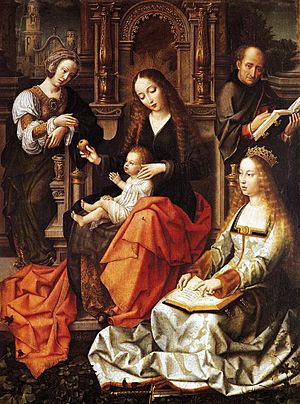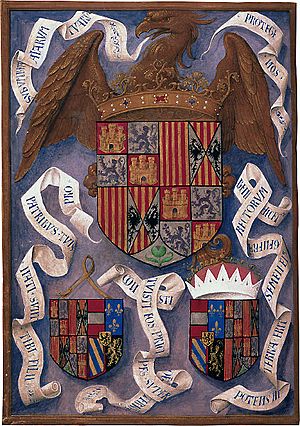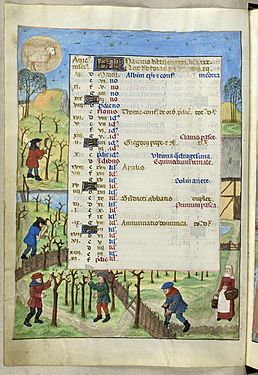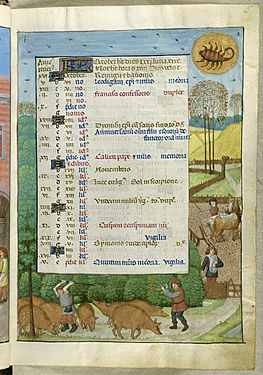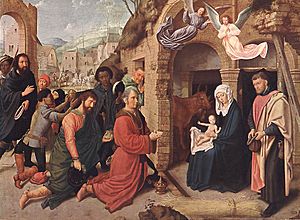Isabella Breviary facts for kids
The Isabella Breviary (also known as Ms. 18851) is a beautiful old book from the late 1400s. It's a special type of book called an illuminated manuscript, which means it has amazing drawings and decorations. This book is kept safe in the British Library in London. Queen Isabella I of Castile received this book as a gift around 1497. It was given to her by her ambassador, Francisco de Rojas, to celebrate the marriages of her children to the children of Emperor Maximilian of Austria and Duchess Mary of Burgundy.
Contents
How the Breviary Was Made
The Breviary of Isabella I of Castile is a type of prayer book called a Breviarium Romanum. It was created in Flanders for a Spanish nobleman named Francisco de Rojas near the end of the 15th century. He gave it to Queen Isabella to celebrate the marriages of her children.
Francisco de Rojas y Escobar was an important diplomat from Spain. He helped arrange the marriages between Isabella's children – Prince Juan and Joanna of Castile – and Margaret of Austria and Philip the Handsome. These marriage plans were finished in 1495. Joanna married Philip in 1496, and Juan married Margaret in 1497. On one of the pages (folio 436 verso) of the book, you can see the coats of arms of the royal families and the newly married couples.
What the Book Looks Like
The Isabella Breviary is written in medieval Latin and follows the rules of the Dominican religious order. It has 523 pages, called folios, and each page measures about 230 x 160 millimeters (about 9 x 6 inches). The text is written in a round, gothic style of writing called gotica rotunda, in two columns with 34 lines each. Red ink was used to draw the lines for the text, but they are hard to see now.
This book has 170 miniatures, which are small, detailed paintings. It's one of the most beautifully decorated breviaries that still exists! These miniatures are found throughout the book:
- Calendar: 12 miniatures
- Special prayers for different times of the year (Proprium de tempore): 50 miniatures
- Psalms: 27 miniatures
- Prayers for saints (Proprium et commune Sanctorum): 81 miniatures
There are two main types of miniatures: some take up a whole page, and others are only as wide as one column of text. The book also has 12 calendar pages, one full-page miniature, and a page with coats of arms. There are also eight special decorated letters, called historiated initials, though one was never finished.
The calendar in the book is a Flemish style calendar. This means that not every day of the month is assigned to a saint or a special feast day; many days are left blank.
Experts believe the book was made in two stages because the parchment, handwriting, and decorations change slightly starting from page 402.
Breviaries for Everyday People
Queen Isabella had many breviaries, not just this one. She owned at least twenty of them! We can only guess why she collected so many. Back then, it was common for noble ladies to have a book of hours for their personal prayers. A breviary, however, was usually a book for priests and other clergy members.
Perhaps, since many people, even those who weren't super rich, started owning fancy books of hours, the highest class wanted something even more special. A breviary was seen as a more "professional" prayer book. The Isabella Breviary was also larger, which allowed for even more amazing artwork.
Many breviaries were highly decorated and showed off a person's wealth and status. But they weren't always practical because they were expensive, heavy, and easily damaged. Smaller versions, often called Books of Hours, were used for everyday devotion. After Queen Isabella died, many of her breviaries and books of hours were sold.
The idea of breviaries for everyday people first started with the French royal family. Soon, the Dukes of Burgundy and later the Spanish and Portuguese royal families followed this trend.
The Book's Journey Through Time
We don't know who owned the Isabella Breviary right after Queen Isabella died. In 1883, a historian named Waagen said that the French took it from the Escorial (a royal palace in Spain) during a war in 1794.
By 1815, the book was owned by John Dent, a British collector. After he died in 1826, his collection was sold. The breviary was sold for £378 to Philip Hurd.
Five years later, after Hurd died, the book was sold again. This time, John Soane, an architect, bought it for £520. Soane then sold it to Sir John Tobin for £645. While Sir John Tobin owned the book, two experts, Frederic Madden and Gustav Friedrich Waagen, were able to study it. Waagen was very impressed by a painting of St. John on Patmos (f309r), which is now believed to be by the artist Gerard David.
When Sir John Tobin died in 1851, his collection went to his son. A bookseller offered £1900 for eight manuscripts, including the breviary. After the deal, the bookseller offered the collection to the British Museum for £3000. After some thought about the price, the museum bought it.
What's Inside the Breviary
A breviary contains the daily prayers, hymns, Psalms, readings, and notes used by clergy members (like bishops, priests, and monks) for their daily prayers, known as the Divine Office. The main part of medieval breviaries was the Psalter, which has 150 psalms (songs or poems) believed to be written by King David. In monasteries, these 150 psalms were recited every week. Over time, other prayers, like hymns and readings, were added. The breviary became a single book that held all the prayers needed for daily worship. The idea of having all these prayers in one portable book became popular with traveling friars.
The Isabella Breviary has the usual sections found in a Dominican breviary. Here are some of them:
- Calendar (ff. 1v – 7r): This section lists important dates and feast days.
- Prayers for the Liturgical Year (Proprium de Tempore, ff. 8v – 110v and ff. 211r – 288v): These are prayers for different times of the year, starting with the first Sunday of Advent and going through Holy Saturday, and then from Easter to the last Sunday before Advent.
- The Psalms (ff. 111v – 194r): This section contains the 150 psalms.
- Canticles (ff. 194r – 197v): These are hymns or prayers from the Bible.
- Litany of the Saints (ff. 198r – 200r): A list of saints to pray to.
- Rules for Use (Rubrics, ff. 203r – 208r): These pages explain how to use the breviary and how to choose prayers for different feast days.
- Prayers for Saints (Proprium Sanctorum, ff. 293r – 498r): This section has prayers for specific saints' feast days, starting with Andrew the Apostle and ending with Saturnin of Rome.
- Common of Saints (commune sanctorum, ff. 498r – 508r): This section contains prayers that can be used for groups of saints or saints without specific individual prayers.
- Little Office of the Blessed Virgin Mary (ff. 508v – 512v)
- Office of the Dead (ff. 512v – 514r)
The Calendar
The calendar in the breviary is based on the standard Dominican calendar. It includes feast days for saints especially important to the Dominicans. For example, it lists days for Thomas Aquinas, Vincent Ferrer, Peter of Verona, and Dominic.
The calendar also tells you the "ranking" of each feast day (like "simplex," "duplex," etc.). This ranking helps decide which prayers to say if a saint's day falls on the same day as another important feast. The rules for this are explained in the "Rubrics" section.
The calendar also includes information needed to figure out the day of the week for any date, and when the sun enters different zodiac signs. At the top of each month, it tells you the number of days and the length of day and night.
Prayers for the Liturgical Year
This section, called the proprium de tempore, holds the prayers for the entire church year, starting with Advent. It tells you which prayers to say for the daily prayer times, such as Matins, Lauds, and Vespers. These prayers include psalms, hymns, readings from the Old and New Testaments, and sermons. Instead of repeating all the prayers, the book often refers you to other sections where the full prayer can be found. These references are written in red ink and are called rubrics.
For Sundays and major holidays, the prayers actually begin the evening before, which was a common practice.
The Isabella Breviary is unique because its "temporal" section is split into two parts by the Psalter. This might mean that the original book it was copied from was actually two separate books (a winter and a summer breviary). It's thought that the Isabella Breviary was made in two stages: first the winter part and the Psalter, then the summer part and the rest of the book.
The Psalter
The Psalter section contains the 150 psalms from the Book of Psalms in the Bible. The order in which these psalms are recited during the week depends on the specific religious tradition. The Isabella Breviary follows the Dominican tradition. The psalms are listed in numerical order, but some are repeated in other places to make it easier for the user to find them when needed for specific daily prayers.
Prayers for Saints
The proprium Sanctorum, or Sanctoral, is similar to the Temporal but contains prayers for saints' feast days. It usually matches the calendar, but there can be small differences.
This section has the most illustrations in the book. The choice of which saints to illustrate often depends on the specific religious order the breviary was made for. Since this one was for Dominican use, important Dominican saints like Dominic, Thomas Aquinas, and Catherine of Siena are featured prominently. The small pictures often show symbols of the saint, their martyrdom, or a special event from their life.
The Book's Artwork
The artwork in Isabella's Breviary helped organize the text and make the book easier to use. The largest paintings mark the most important sections or feast days. Smaller ones show subsections or less important days. Decorated letters and border designs add to the beauty and mark divisions in the text.
For example, in the winter part of the Temporal, large, page-wide miniatures are used for major Sundays and feast days. Smaller Sundays have column-wide miniatures, and weekdays have partial borders and large decorated letters. The Matins (morning prayers) for Maundy Thursday even have 16 column-wide miniatures showing the Passion of Christ.
In the Psalter, page-wide miniatures introduce the opening psalms for Sunday and weekdays. Smaller miniatures mark the beginning of other psalms.
The summer part of the Temporal uses page-wide miniatures for important feasts like Easter, Ascension, and Pentecost. In the Sanctoral, page-wide miniatures are saved for very important saints and Dominican saints. Other saints' offices have column-wide miniatures or decorated initials.
Page-Wide Miniatures
The book has many page-wide miniatures, usually 24 lines high. These are always surrounded by a full border decoration on all four sides and a large, decorated initial letter. Some examples include:
- The twelve Sibyls (f8v): A full-page painting at the start of the winter part.
- The adoration of the shepherds (f29r): For Christmas.
- The Temptation of Christ (f71r): For the first Sunday of Lent.
- The Crucifixion (f106v): For Good Friday.
- Nebukadnezar burning the books of the Temple (f111v): At the start of the Psalter.
- The Risen Christ (f211r): For the summer part, Holy Saturday.
- The Ascension of Jezus (f228r): For the Feast of the Ascension.
- Martyrdom of St. Andrew (f293r): The first saint in the Sanctoral.
- Saint Barbara (f297r): Showing her in a garden with her tower.
- John on Patmos (f309r): Showing him writing with his symbol, the eagle.
- Annunciation (f354r): Showing the angel Gabriel telling Mary she will have Jesus.
- Full-page miniature with the arms of Ferdinand and Isabella (f436v).
- All Saints in heaven (f477v).
Column-Wide Miniatures
Smaller, column-wide miniatures divide the text within major sections. For instance, the second, third, and fourth Sundays of Advent are marked with these miniatures. Many small miniatures also illustrate the text, like the scenes of Christ's Passion on pages 101r to 104r.
These smaller miniatures are also used in the Psalter to mark the beginning of psalms for different prayer times. In the Sanctoral, they often show scenes from saints' lives or their symbols.
Calendar Miniatures
The calendar miniatures are different from the others. They are purely for decoration and are the only true full-page miniatures in the book. They show scenes of daily life and work for each month, with the zodiac sign for the month in a corner. This style of calendar illustration, where the text is written over a full-page scene, was quite new when the Isabella Breviary was made.
Initials and Line Fillers
The book has thousands of decorated initial letters, ranging from one to eight lines high. They are drawn with blue or purple ink on a gold background, often with geometric patterns or vines. These initials also help organize the text, for example, each psalm starts with a three-line initial.
If a line of text ends with an empty space, it's filled with a gold bar decorated with designs. In the Psalter, these are used to mark the end of each psalm verse.
Borders
Many pages have beautiful border decorations. Any page with a large or small miniature has a full border on all four sides. The space between the two columns of text is also decorated.
The Isabella Breviary shows two main styles of border decoration:
- Outmoded French style: This older style has delicate designs of leaves, flowers, and gold dots painted directly on the parchment.
- Ghent-Bruges style: This "modern" style, popular in Flanders, has the decoration painted on a colored background, usually yellow. It features wider branches, flowers, insects, and sometimes even tiny human figures.
Some borders are very unique, looking like fabric or made of large capital letters. The image of Saint Barbara at the top of this article shows an example of a fabric-like border. Besides full borders, there are also smaller, partial borders used with decorated initials to organize the text on almost every page.
The Artists Who Created It
Several artists worked on the Isabella Breviary, each with their own unique style.
Master of the Dresden Prayer Book
This artist painted the most miniatures in the book, including one full-page, 32 page-wide, and 52 column-wide miniatures. This master was very creative and didn't just copy old designs. His illustrations for the Psalter were completely new for Flanders. He likely got ideas from a theologian, perhaps a Dominican, who advised him on the religious themes.
Experts used to think his work was done around the 1490s, but newer research suggests it was earlier, in the 1480s, before he left Bruges for a few years.
Calendar Master
The calendar illustrations were done by a different artist, even though the Master of the Dresden Prayer Book was known for calendars. This artist also worked on some of the Ghent-Bruges style border decorations. Artistically, the calendar is considered the weakest part of the book's artwork.
Gerard David
When the book was first studied in 1838, an art historian named Gustav Friedrich Waagen noticed that four miniatures were exceptionally good: the nativity scene (f29r), the Adoration of the Magi (f41r), St. Barbara (f297r), and John on Patmos (f309r). Waagen thought these four were by the same artist. Today, many experts believe these four miniatures were painted by Gerard David, a very important artist in Flanders at the time. The way these miniatures are painted, with their rich colors and detailed figures, makes them stand out from the other artworks in the first part of the book.
Master of James IV of Scotland
This artist is also known by a nickname, and some scholars think he might be Gerard Horenbout. He was a major artist between 1480 and 1530 and worked on other famous breviaries like the Breviarium Mayer van den Bergh and the Breviarium Grimani.
The Master of James IV of Scotland painted 48 miniatures in the second part of the Isabella Breviary, mostly in the second half of the Sanctoral. These miniatures are usually column-wide. His work is dated to the 1490s. A special feature of his miniatures is that they are always surrounded by a golden, three-dimensional frame.
Later Updates
Some parts of the book were finished by other artists.
- English artist, early 1800s: Some miniatures, like the one of Saint Catherine and four small column-wide ones, were added later, in the early 19th century. Their style looks more like oil paintings from that time.
- Spanish artist, around 1500: Other miniatures that weren't done by the main artists are thought to be by a Spanish artist. This is based on the style and the clothing of the figures, and a classical temple shown in one miniature. It's not clear if this artist finished the book after the main work was done, or if they started earlier but were replaced because their work wasn't as high quality.
See also
In Spanish: Breviario de Isabel la Católica para niños


